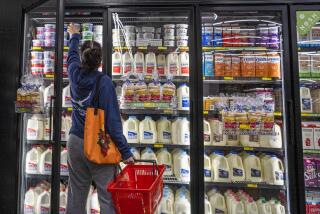Consumer Prices Climb 0.5% in March
- Share via
WASHINGTON — Consumer prices, propelled by a record rise in clothing costs, shot up 0.5% in March, the biggest increase since January, 1987, the government said today.
Besides the 2% jump in apparel costs, retail prices were also driven upward by a 0.4% gain in gasoline costs, the first rise since August, and a 0.3% hike in food prices.
Taken together, clothing, food and transportation price increases accounted for half the March jump, which was more than double the 0.2% gain of February.
Fears of Inflation
The overall gain--amounting to 6.4% on an annual basis--heightened economists’ concerns that inflation may be rebounding. The consumer price index had risen a moderate 4.4% last year and a tiny 1.1% in 1986.
“This is the first dose of inflation we have had since the first half of 1987,” said Donald Ratajczak, head of the forecasting project at Georgia State University. “If things don’t settle down by May, then I think the Federal Reserve will have to put fighting inflation pretty high on the agenda.”
The central bank fights inflation by raising interest rates and thus slowing the pace of economic activity. While economists had not expected the Fed to slow economic growth during a presidential election year, many analysts now believe that the Fed has already taken a small step toward tightening credit, with more steps to come.
Sharp Rise in Clothing Costs
Today’s Labor Department report blamed the sharp increase in clothing costs--the steepest one-month increase since records were first kept in 1947--on “substantially higher priced spring and summer merchandise, particularly women’s clothing.”
Indeed, prices for women’s and girls’ clothing rose 3.9% after falling in January and February. Prices for men’s and boys’ apparel were up 1.2%.
Clothing prices normally rise in the spring. Last month’s jump--3.7% once the department’s seasonal adjustment process is factored out--was even greater than analysts had expected, however.
Gasoline prices rose 0.4% after falling 1.7% in February and 1.6% in January. From September through February, gasoline prices had fallen 5.9%.
Grocery store prices rose 0.4% after falling 0.6% in February.
Leading the way was a 0.2% gain in prices for fresh fruits and vegetables. Virtually all the increase was in fresh fruit prices while the costs of fresh vegetables continued to decline.
More to Read
Inside the business of entertainment
The Wide Shot brings you news, analysis and insights on everything from streaming wars to production — and what it all means for the future.
You may occasionally receive promotional content from the Los Angeles Times.










